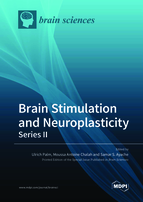Brain Stimulation and Neuroplasticity—Series II
A special issue of Brain Sciences (ISSN 2076-3425). This special issue belongs to the section "Systems Neuroscience".
Deadline for manuscript submissions: closed (10 April 2022) | Viewed by 32770
Special Issue Editors
2. Medical Park Chiemseeblick, Bernau, Felden, Germany
Interests: non-invasive brain stimulation; transcranial direct current stimulation; depressive disorder; cognition; multiple sclerosis fatigue
Special Issues, Collections and Topics in MDPI journals
2. Service de Physiologie - Explorations Fonctionnelles, Hôpital Henri Mondor, Assistance Publique - Hôpitaux de Paris, 94000 Créteil, France
Interests: neurosciences; multiple sclerosis; Transcranial Magnetic Stimulation (TMS); Transcranial Direct- Current Stimulation (tDCS)
Special Issues, Collections and Topics in MDPI journals
2. Neurophysiology Department, Henri Mondor Hospital, 94010 Creteil, France
Interests: multiple sclerosis; MS fatigue; MS pain; neurophysiology; evoked potentials; electroencephalography; non-invasive brain stimulation
Special Issues, Collections and Topics in MDPI journals
Special Issue Information
Dear Colleagues,
Due to the great success of our Special Issue "Brain Stimulation and Neuroplasticity" we decided to set up a second volume. A large number of qualified submissions confirmed the importance of non-invasive brain stimulation methods in recent years, and showed a broad field of applications.
Again, this second volume of the Special Issue aims to gather pre-clinical and clinical data on brain stimulation techniques (electrical and magnetic stimulation methods).
It still compiles the newest research on the clinical and neurophysiological application of brain stimulation methods, and the impact of brain stimulation on imaging outcomes, neurobiological markers, and clinical variables (including neurological, affective, and cognitive measures).
For this second volume, we are encouraging authors to submit review articles, case reports and case series, pilot studies, and randomized controlled clinical trials.
We invite you to read the Special Issue "Brain Stimulation and Neuroplasticity" at mdpi.com/si/60360
Dr. Ulrich Palm
Dr. Moussa Antoine Chalah
Dr. Samar S. Ayache
Guest Editors
Manuscript Submission Information
Manuscripts should be submitted online at www.mdpi.com by registering and logging in to this website. Once you are registered, click here to go to the submission form. Manuscripts can be submitted until the deadline. All submissions that pass pre-check are peer-reviewed. Accepted papers will be published continuously in the journal (as soon as accepted) and will be listed together on the special issue website. Research articles, review articles as well as short communications are invited. For planned papers, a title and short abstract (about 100 words) can be sent to the Editorial Office for announcement on this website.
Submitted manuscripts should not have been published previously, nor be under consideration for publication elsewhere (except conference proceedings papers). All manuscripts are thoroughly refereed through a single-blind peer-review process. A guide for authors and other relevant information for submission of manuscripts is available on the Instructions for Authors page. Brain Sciences is an international peer-reviewed open access monthly journal published by MDPI.
Please visit the Instructions for Authors page before submitting a manuscript. The Article Processing Charge (APC) for publication in this open access journal is 2200 CHF (Swiss Francs). Submitted papers should be well formatted and use good English. Authors may use MDPI's English editing service prior to publication or during author revisions.









